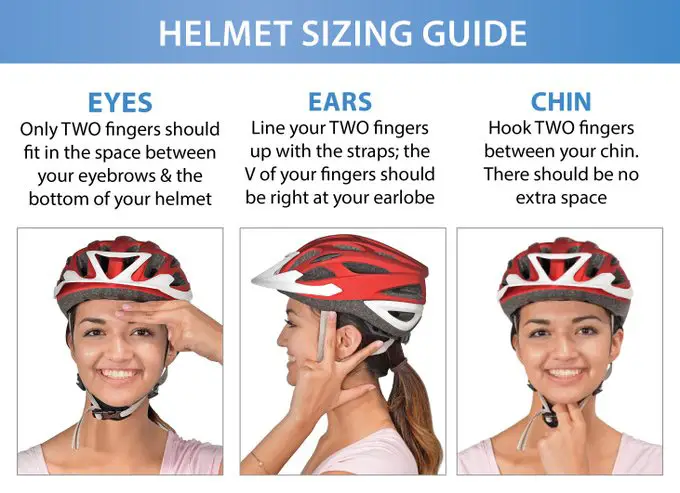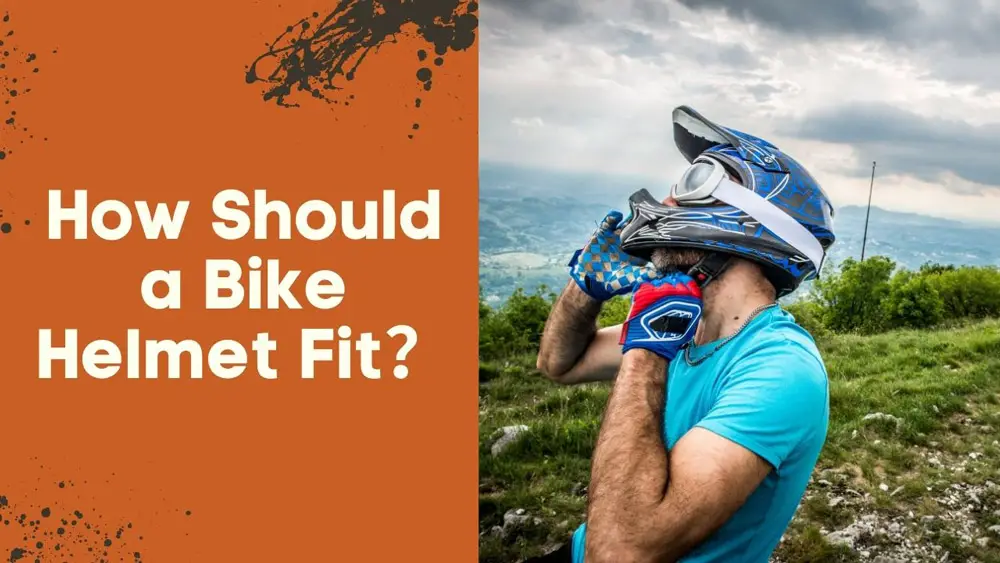Are you a passionate biker looking to buy a new bike helmet?
If yes, you should take a few moments to figure out the perfect size for the most comfortable experience. Even people with years of experience may get the sizing wrong if some considerations are ignored.
Now, you may already know the best brands for comfortable helmets, but how should a bike helmet fit? Read on to find out.
How Should a Bike Helmet Fit?
To check for correct fit, place the bike helmet on your head. Make sure it sits level to the ground and low on your forehead with the front edge no more than one inch (two fingers) above your eyebrows so that it provides protection for frontal impacts. Adjust the slider on both straps so they form a “Y” shape under your ears.
A good-fitting bike helmet will not be too high up to expose your forehead or too low to block your vision. The chin straps should sit below the ears without too much gap. If you open your mouth, the helmet should press upon the head. If it’s a mountain bike helmet that has a visor, it should be parallel to the ground as well.
How Can I Tell If My Road or MTB Helmet Fits Properly?
There are a few ways to tell if the bike helmet fits you correctly or not. Firstly, once you place the helmet over your head, it should fit close and snug but not tight after buckling the chin strap. Ideally, the helmet should not shake up or down after wearing it nor move side to side.
Also, you can know the helmet is loose if it tilts back on your head. Instead, it needs to stay forward and low on your forehead. Make sure the helmet stays firmly in place on the forehead with a two-finger gap to your eyebrows.
Additionally, use this quick test- wear the helmet and look upwards; the topmost edge of the helmet should be within your line of sight. Next, check the straps on each side – they should form a “Y” shape with the ears between them. The distance should not be too far from the earlobe.
After you buckle up, you should be able to insert only one finger between the buckle and the chin; anything looser is too loose. Finally, the helmet should press against the head if you open your mouth.
Find The Right Bike Helmet Size
It’s possible to measure your head and find a close size for purchasing a bike helmet online. Use a flexible tape such as cloth tape or a string and ruler to measure the circumference of your head. Turn the tape around your head horizontally, preferably with the help of a friend, for accuracy. Take the tape over the ears and brows too.
Depending on the company you choose to buy the helmet from, there should be size charts on the website. Yet, it is best to try the helmet on with the chin straps before making a purchase.
You might be interested in this guide: The 7 Best Low-Profile Bike Helmets
What Can I Do If I Have Trouble Fitting the Bicycle Helmet?
In the best-case scenario, the helmet should fit all around the head, provide stability, resist sudden head shakes but not be too tight. As such, you’ll have to be patient and prepared to try many helmets to get the perfect fit.
Adjust The Fit Pads or Ring
One-size-fits-all helmets contain a ring for individual adjustment. You can tighten or loosen them based on your requirement. If adjusting does not help, the helmet probably isn’t for you.
Other helmets come with two sets of foam pads, the second foam layer being the adjustable one. If the helmet is tight, you can remove one layer entirely, and if the head is narrower, you can adjust the soft pads to the side. It is recommended to leave some gaps in the pads so that it doesn’t get stuffy.
Adjust The Straps
After buckling the straps conduct an eye-ear-mouth test. You should be able to see the rim and the Y portion below the ears, and opening the mouth should press the helmet down.
How To Properly Fit a Bike Helmet?

For safety reasons, it is best to use a bike helmet that fits you properly. Also, the correct size will be comfortable, allowing you to bike for longer without distractions. If you like a helmet model, it’s best to try it out in person.
Yes, it’s always possible to measure your head shape accurately, but each helmet has an individual shape and volume that will fit differently. Despite measuring their head, we’ve seen bikers riding along the street wearing helmets incorrectly.
One simple thing you should do is wear the chinstrap tight and firm. Chinstraps should hug your face and sit where your jaw ends and the neck begins. Anything slightly looser than this will move the helmet around, and you want to avoid that.
However, the chinstrap should not choke you as you move about. Instead, it needs to be tight enough to stay on your head if you happen to get off the moving bike at 40 mph.
Next, remember to keep the front of the helmet on the forehead. Several bikers make the mistake of pushing the helmet showing the entire forehead. Avoid this gap by placing the helmet level on the head. As we mentioned earlier, there should be a two-finger gap between your eyebrows and the helmet, not more.
Final Thoughts
Ultimately, the helmet you select should be comfortable to wear for extended periods of time. Apart from fit and size, you should like the feel, design, color, and overall appearance if you’re buying a new one.
Either way, a well-fitted bike helmet can accompany you on each biking expedition and last you ages.


